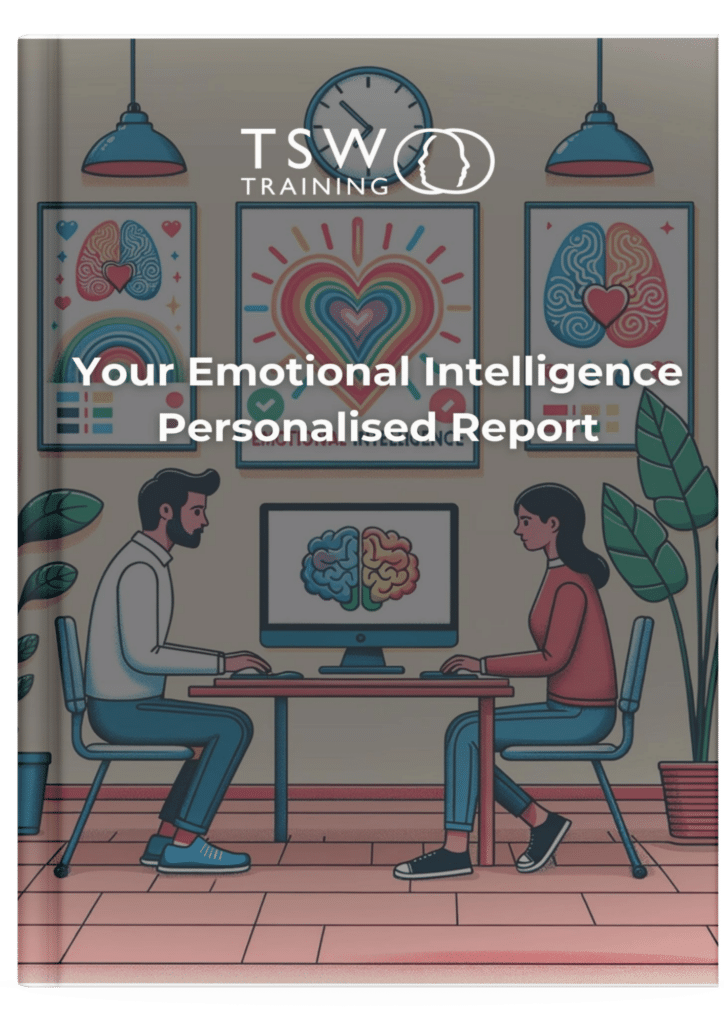The benefits of emotional intelligence in the workplace can run deep, helping teams work together more effectively, reducing conflict, and creating a more trusting environment.
Emotional intelligence also has a significant place in improving decision-making, problem-solving, and communication, a symptom of employees better understanding their customers and colleagues.
Emotional intelligence grew in popularity after Daniel Goleman published his 1995 book Emotional Intelligence – Why it can matter more than IQ.
It’s a skill that can help greatly in the workplace as it can improve communication, comprehension, relationships and more.
What is emotional intelligence (EQ)?
Emotional intelligence (EQ) is understanding and managing your own and other people’s thoughts and feelings.
In Goleman’s book, he lists five stages of EQ, which are:
- Self-awareness: knowing how you think and feel
- Self-regulation: recognising and controlling your feelings and actions
- Motivation: understanding what drives other people’s thoughts, feelings and actions
- Empathy: relating to the thoughts and feelings of others
- Social skills: how you interact with others
To some people, EQ comes naturally. But for those who don’t have the innate ability, it’s a skill that can be improved. Whether you’re born with it or develop emotional intelligence through training, it can be a huge benefit in the workplace.
Why is emotional intelligence important in the workplace?
Building on the foundation of the concept, let’s delve deeper into its significance in the workplace and it’s potential impact, good and bad.
11 benefits of emotional intelligence in the workplace
Evaluating employee EQ can help organisations get a more in-depth look at how and why a person thinks, feels and acts the way they do. Here are a few benefits of developing emotional intelligence in the workplace.
#1. Communication
EQ can help employees express themselves in a suitable way and learn how to react in various social situations.
For example, if a co-worker raises a topic you’re not comfortable with, you’d be able to calmly move the conversation onto more neutral ground, instead of reacting too quickly and escalating the situation.
Improvements in communication will seep through into your customer-facing channels too, so you can enhance the customer experience with content and processes that are easier to understand.
#2. Comprehension
Developing your employees’ emotional intelligence can prepare them to respond to constructive feedback, help them understand and deal with change, as well as increase accountability.
Say your team has received some structured feedback, which has led to some changes in working processes. This sudden change can be unsettling, but if your team has high EQ they’ll be able to rationalise the decision and will understand that it’s actually a good thing.
If your employees are supportive and welcoming of change and constructive feedback, they’re also more likely to take accountability for mistakes and focus on the resolution, instead of playing the blame game.
#3. Relationships
Employees with high emotional intelligence will reduce conflict, as they’ll be able to regulate their feelings and gauge how best to react. EQ can also help leaders spot mental health risks and better look out for their team.
An example could be that two team members have opposing ideas, but as they’ve recently taken an emotional intelligence training course, they’re able to have a constructive conversation and find a compromise themselves. As one of the roles of a team leader is care for the health, safety and welfare of your people, they will check in with each person afterwards to check they’re okay and check there weren’t other factors behind the conflict.
Less conflict means a stronger feeling of unity within the team, which can make a huge difference to morale.
#4. Enhanced Teamwork & Collaboration:
When individuals possess high EQ, they can better sense the feelings and needs of their colleagues. This fosters an environment of mutual respect and understanding. In such a setting, collaboration thrives as team members are more inclined to support one another, valuing each individual’s contributions.
#5. Morale
Another benefit of developing EQ in the workplace is that it can be a big boost to morale. If your employees can understand their actions and emotions, this clearer view can help reduce stress and improve confidence, as well as give your employees the ability to turn negatives into positives.
This could be useful in a situation where an employee is falling behind with their work – having high emotional intelligence would allow them to regulate their stress and examine the cause to find a solution.
#6. Productivity
Your employees can feel more productive if they have a well-developed EQ. This is because your employees will be better equipped to identify thEQr limits and motivations.
For example, a team member might be considering applying for a role in another department. Because they have worked hard to develop their emotional intelligence, they’re able to use their self-awareness to evaluate their strengths and weaknesses to find out whether they are a good fit for the position, and whether it aligns with what motivates them.
Generally, EQ can help your employees with their career progression which in turn helps the organisation thrive as the employees don’t feel stuck in their current role and take their talent somewhere they can continue to grow.
#7. Stress Management & Resilience
Workplaces can be high-stress environments. Employees with high emotional intelligence can identify their emotional responses to stress and use effective strategies to manage and mitigate its impact. This resilience not only benefits the individual but also creates a more stable work environment where challenges are met with composure.
#8. Conflict Resolution
Disagreements are inevitable in any organisation. However, with high EQ, conflicts can be approached with understanding and empathy, leading to quicker and more amicable resolutions. Instead of letting disputes fester or escalate, emotionally intelligent individuals can mediate and find common ground.
#9. Enhanced Customer Relations
In customer-facing roles, emotional intelligence is invaluable. By tuning into a customer’s emotions and needs, employees can offer better service and build stronger relationships. This results in increased customer satisfaction and loyalty.
#10. Personal Growth & Development
Beyond the collective benefits, emotional intelligence paves the way for personal growth. It promotes introspection, self-reflection, and self-improvement. When employees feel this personal growth, they are more likely to be engaged, motivated, and committed to their roles.
#11. Flexibility and Adaptability
The corporate world is in constant flux. Emotionally intelligent individuals can more readily adapt to changes, not just by managing their reactions but by understanding the reactions of others. This makes organisational transitions smoother and more efficient.
With these 11 benefits, it’s clear that emotional intelligence is more than just a buzzword or a trend. It’s a vital skill that impacts numerous facets of the workplace.
Organisations and individuals alike stand to gain significantly by understanding, valuing, and enhancing EQ. But, at the same time, it is important to understand any downsides and take steps to tackle them.
Are there any disadvantages of emotional intelligence?
One disadvantage is that emotional intelligence can’t always be measured by standard personality tests as these only study a person’s surface-level temperament.
For example, if you were reviewing candidates for a customer-facing role, you’d likely want to hire someone who is outgoing, confident and friendly as your customers would have an easier time engaging with them. You could ask a few questions from a personality test to give you a general idea of whether someone is gregarious or reserved.
Luckily there are specific emotional intelligence assessments that you can use to understand a person’s inner traits, like if they are empathetic or indifferent. An empathetic person would be able to understand a customer’s thoughts and feelings, while someone who is more aloof might not pick up on the same social cues, which could lead to a missed opportunity or even alienate the customer.
Another downside to emotional intelligence is that it can be used to manipulate. If someone is good at controlling how they feel and managing the emotions of others, then they could use this to their own advantage, like to gain unwarranted praise or to mislead investors and stakeholders.
A few more problems that can arise with emotional intelligence are:
- Limited creativity
- Struggles with negative feedback
- Hesitant to make unpopular choices
⏰Key point: It’s important to note that as long as employees are allowed to grow, feel secure and their needs are met, their emotional intelligence should be well-rounded, which minimises the risk of these disadvantages.
How can emotional intelligence be improved for the benefit of the workplace?
There are four steps you can take to improve emotional intelligence in the workplace.
#1. Emotional intelligence assessments
As previously mentioned, Goleman’s emotional intelligence test measures self-awareness, self-regulation, motivation, empathy and social skills.
By taking an emotional intelligence test you will gain a comprehensive understanding of what you need to work on. Leaders and managers can also use EQ tests to assess their team’s strengths and areas for development, which will inform their planning for team development.
#2. Emotional intelligence training
Now you know where your employees are in terms of the 5 key steps, you can choose a training course to build on their emotional intelligence. Some training courses start with an emotional intelligence test, so you may even be able to skip step one.
To improve emotional intelligence in the workplace, it’s also a good idea to combine an official training course with other self-guided learning. For example, you could ask your employees to meditate, use an emotion wheel, complete a workbook or engage in team outings.
#3. Analysis and feedback
To find out whether the emotional intelligence training and self-learning worked, you’re going to have to be patient – you’ll need to measure the effectiveness over time.
Here are a few things to look out for:
- Improved engagement
- Increased efficiency
- Lower employee turnover
- Less conflict
- Fewer customer complaints
To measure the success of the training, you could send out an engagement survey before the training starts to determine a baseline, and then regular but not too frequent follow-up surveys – say once every quarter.
Some emotional intelligence courses may have some sort of post-study research element which can help you judge the success.
#4. Reflect and improve
Now you’ve made your analysis, it’s time to reflect. Does it show that the training was successful? Are there any improvements that can be made before the next team begins developing their emotional intelligence?
You can use the feedback from participants to work out what went well, what didn’t and whether there are any learning gaps that can be filled.
Further reading:
- The Top 10 Books & Other Resources About Emotional Intelligence – recommended reading by Matthew Channell, Director at TSW Training.
Take our free emotional intelligence test today and get a detailed report with targeted tips and techniques to skyrocket your EQ.








